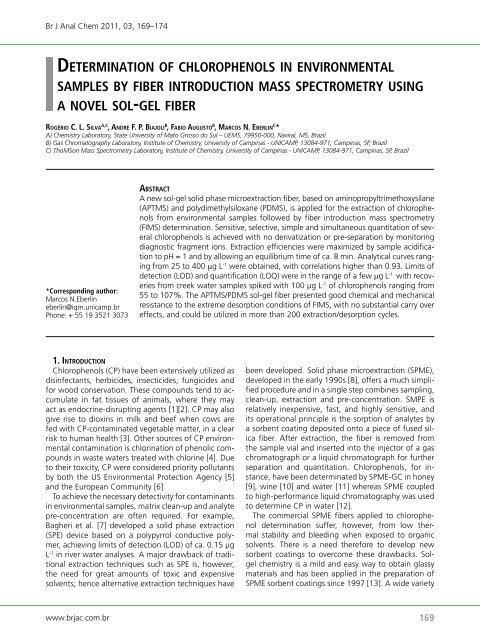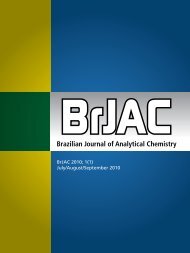Brazilian Journal of Analytical Chemistry - BRJAC - Brazilian Journal ...
Brazilian Journal of Analytical Chemistry - BRJAC - Brazilian Journal ...
Brazilian Journal of Analytical Chemistry - BRJAC - Brazilian Journal ...
You also want an ePaper? Increase the reach of your titles
YUMPU automatically turns print PDFs into web optimized ePapers that Google loves.
Br J Anal Chem 2011, 03, 169–174<br />
dE t E r m i n a t i o n o f C h l o ro P h E n o l s in E n v i ro n mE n t a l<br />
samPlEs By fiBEr i n t ro d uC t i o n m a s s sPECtromEtry u s i n g<br />
a n o v E l s o l-g E l fiBEr<br />
ro g é r i o C. l. silva a,C , an d r E f. P. Bi a J o l i B , fa B i o au g u s t o B , ma rC o s n. EBErlin C *<br />
A) <strong>Chemistry</strong> Laboratory, State University <strong>of</strong> Mato Grosso do Sul – UEMS, 79950-000, Naviraí, MS, Brazil<br />
B) Gas Chromatography Laboratory, Institute <strong>of</strong> <strong>Chemistry</strong>, University <strong>of</strong> Campinas - UNICAMP, 13084-971, Campinas, SP, Brazil<br />
C) ThoMSon Mass Spectrometry Laboratory, Institute <strong>of</strong> <strong>Chemistry</strong>, University <strong>of</strong> Campinas - UNICAMP, 13084-971, Campinas, SP, Brazil<br />
*Corresponding author:<br />
Marcos N.Eberlin<br />
eberlin@iqm.unicamp.br<br />
Phone: + 55 19 3521 3073<br />
www.brjac.com.br<br />
aBstraCt<br />
A new sol-gel solid phase microextraction fiber, based on aminopropyltrimethoxysilane<br />
(APTMS) and polydimethylsiloxane (PDMS), is applied for the extraction <strong>of</strong> chlorophenols<br />
from environmental samples followed by fiber introduction mass spectrometry<br />
(FIMS) determination. Sensitive, selective, simple and simultaneous quantitation <strong>of</strong> several<br />
chlorophenols is achieved with no derivatization or pre-separation by monitoring<br />
diagnostic fragment ions. Extraction efficiencies were maximized by sample acidification<br />
to pH = 1 and by allowing an equilibrium time <strong>of</strong> ca. 8 min. <strong>Analytical</strong> curves ranging<br />
from 25 to 400 µg L -1 were obtained, with correlations higher than 0.93. Limits <strong>of</strong><br />
detection (LOD) and quantification (LOQ) were in the range <strong>of</strong> a few µg L -1 with recoveries<br />
from creek water samples spiked with 100 µg L -1 <strong>of</strong> chlorophenols ranging from<br />
55 to 107%. The APTMS/PDMS sol-gel fiber presented good chemical and mechanical<br />
resistance to the extreme desorption conditions <strong>of</strong> FIMS, with no substantial carry over<br />
effects, and could be utilized in more than 200 extraction/desorption cycles.<br />
1. in t ro d u C t i o n<br />
Chlorophenols (CP) have been extensively utilized as<br />
disinfectants, herbicides, insecticides, fungicides and<br />
for wood conservation. These compounds tend to accumulate<br />
in fat tissues <strong>of</strong> animals, where they may<br />
act as endocrine-disrupting agents [1][2]. CP may also<br />
give rise to dioxins in milk and beef when cows are<br />
fed with CP-contaminated vegetable matter, in a clear<br />
risk to human health [3]. Other sources <strong>of</strong> CP environmental<br />
contamination is chlorination <strong>of</strong> phenolic compounds<br />
in waste waters treated with chlorine [4]. Due<br />
to their toxicity, CP were considered priority pollutants<br />
by both the US Environmental Protection Agency [5]<br />
and the European Community [6].<br />
To achieve the necessary detectivity for contaminants<br />
in environmental samples, matrix clean-up and analyte<br />
pre-concentration are <strong>of</strong>ten required. For example,<br />
Bagheri et al. [7] developed a solid phase extraction<br />
(SPE) device based on a polypyrrol conductive polymer,<br />
achieving limits <strong>of</strong> detection (LOD) <strong>of</strong> ca. 0.15 μg<br />
L -1 in river water analyses. A major drawback <strong>of</strong> traditional<br />
extraction techniques such as SPE is, however,<br />
the need for great amounts <strong>of</strong> toxic and expensive<br />
solvents; hence alternative extraction techniques have<br />
been developed. Solid phase microextraction (SPME),<br />
developed in the early 1990s [8], <strong>of</strong>fers a much simplified<br />
procedure and in a single step combines sampling,<br />
clean-up, extraction and pre-concentration. SMPE is<br />
relatively inexpensive, fast, and highly sensitive, and<br />
its operational principle is the sorption <strong>of</strong> analytes by<br />
a sorbent coating deposited onto a piece <strong>of</strong> fused silica<br />
fiber. After extraction, the fiber is removed from<br />
the sample vial and inserted into the injector <strong>of</strong> a gas<br />
chromatograph or a liquid chromatograph for further<br />
separation and quantitation. Chlorophenols, for instance,<br />
have been determinated by SPME-GC in honey<br />
[9], wine [10] and water [11] whereas SPME coupled<br />
to high-performance liquid chromatography was used<br />
to determine CP in water [12].<br />
The commercial SPME fibers applied to chlorophenol<br />
determination suffer, however, from low thermal<br />
stability and bleeding when exposed to organic<br />
solvents. There is a need therefore to develop new<br />
sorbent coatings to overcome these drawbacks. Solgel<br />
chemistry is a mild and easy way to obtain glassy<br />
materials and has been applied in the preparation <strong>of</strong><br />
SPME sorbent coatings since 1997 [13]. A wide variety<br />
169



